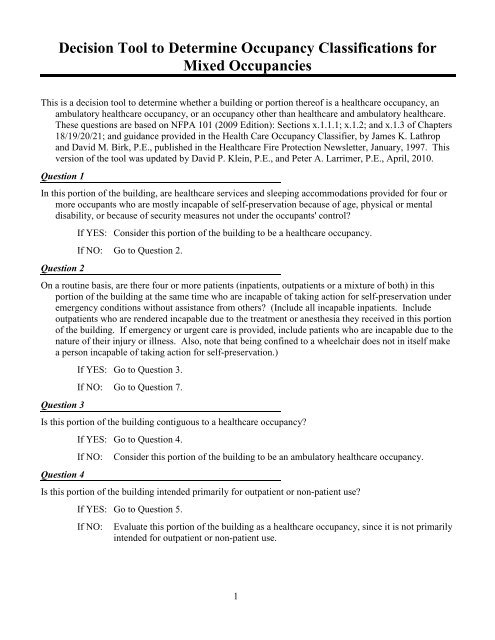Fire Protection Design Manual - Office of Construction and Facilities ...
Fire Protection Design Manual - Office of Construction and Facilities ...
Fire Protection Design Manual - Office of Construction and Facilities ...
You also want an ePaper? Increase the reach of your titles
YUMPU automatically turns print PDFs into web optimized ePapers that Google loves.
Decision Tool to Determine Occupancy Classifications for<br />
Mixed Occupancies<br />
This is a decision tool to determine whether a building or portion there<strong>of</strong> is a healthcare occupancy, an<br />
ambulatory healthcare occupancy, or an occupancy other than healthcare <strong>and</strong> ambulatory healthcare.<br />
These questions are based on NFPA 101 (2009 Edition): Sections x.1.1.1; x.1.2; <strong>and</strong> x.1.3 <strong>of</strong> Chapters<br />
18/19/20/21; <strong>and</strong> guidance provided in the Health Care Occupancy Classifier, by James K. Lathrop<br />
<strong>and</strong> David M. Birk, P.E., published in the Healthcare <strong>Fire</strong> <strong>Protection</strong> Newsletter, January, 1997. This<br />
version <strong>of</strong> the tool was updated by David P. Klein, P.E., <strong>and</strong> Peter A. Larrimer, P.E., April, 2010.<br />
Question 1<br />
In this portion <strong>of</strong> the building, are healthcare services <strong>and</strong> sleeping accommodations provided for four or<br />
more occupants who are mostly incapable <strong>of</strong> self-preservation because <strong>of</strong> age, physical or mental<br />
disability, or because <strong>of</strong> security measures not under the occupants' control?<br />
Question 2<br />
If YES: Consider this portion <strong>of</strong> the building to be a healthcare occupancy.<br />
If NO: Go to Question 2.<br />
On a routine basis, are there four or more patients (inpatients, outpatients or a mixture <strong>of</strong> both) in this<br />
portion <strong>of</strong> the building at the same time who are incapable <strong>of</strong> taking action for self-preservation under<br />
emergency conditions without assistance from others? (Include all incapable inpatients. Include<br />
outpatients who are rendered incapable due to the treatment or anesthesia they received in this portion<br />
<strong>of</strong> the building. If emergency or urgent care is provided, include patients who are incapable due to the<br />
nature <strong>of</strong> their injury or illness. Also, note that being confined to a wheelchair does not in itself make<br />
a person incapable <strong>of</strong> taking action for self-preservation.)<br />
Question 3<br />
If YES: Go to Question 3.<br />
If NO: Go to Question 7.<br />
Is this portion <strong>of</strong> the building contiguous to a healthcare occupancy?<br />
Question 4<br />
If YES: Go to Question 4.<br />
If NO: Consider this portion <strong>of</strong> the building to be an ambulatory healthcare occupancy.<br />
Is this portion <strong>of</strong> the building intended primarily for outpatient or non-patient use?<br />
If YES: Go to Question 5.<br />
If NO: Evaluate this portion <strong>of</strong> the building as a healthcare occupancy, since it is not primarily<br />
intended for outpatient or non-patient use.<br />
1

















